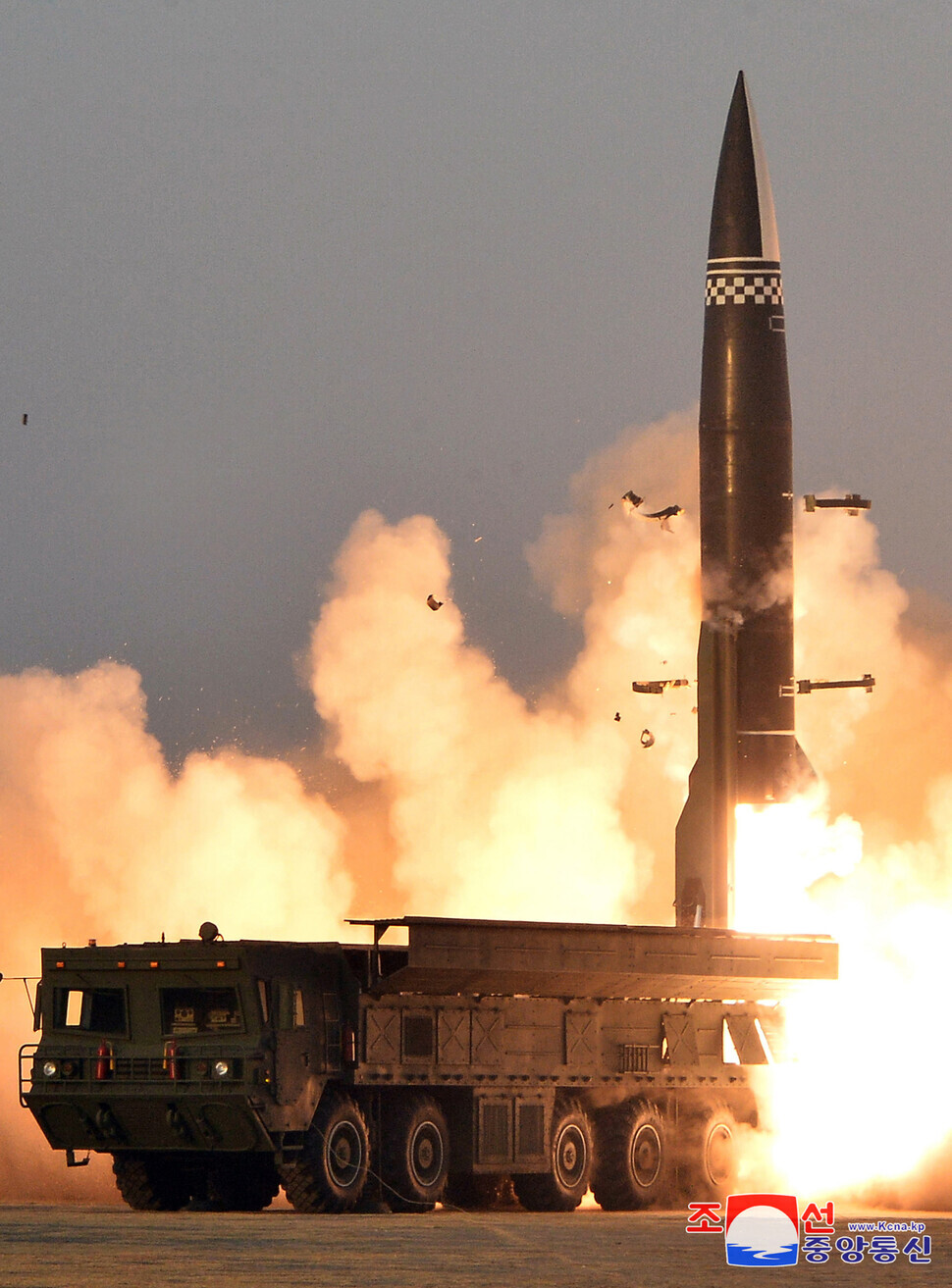hankyoreh
Links to other country sites 다른 나라 사이트 링크
N. Korea’s missile launches parallel those in March. But why?

North Korea’s test launches of two short-range missiles Wednesday three days after launches of a “new type of long-range cruise missile” over the weekend are reminiscent of its activities in March of this year.
The North test-launched two cruise missiles and two ballistic missiles in the space of four days on March 21 and 25, respectively. Six months later, it appeared to be repeating the same pattern.
The UN Security Council (UNSC) prohibits North Korea from conducting any launches that use “ballistic missile technology.” Accordingly, while cruise missile launches are not considered to be in violation of UNSC resolutions, ballistic missile launches are, regardless of type.
To date, the US has not called for convening the UNSC in connection with intermediate-range ballistic missile test launches by North Korea, as opposed to long-range missiles such as intercontinental ballistic missiles (ICBMs). It amounts to tacit consent, where the US doesn’t pursue any practical response beyond verbal criticism.
In that sense, the two short-range ballistic missiles fired by North Korea toward the East Sea from the Yangdok area in South Pyongan Province on Wednesday are unlikely to be the sort of military action that becomes an inflection point in terms of qualitative changes in the political situation on the Korean Peninsula.
According to University of North Korean Studies professor Kim Dong-yup, the North’s ballistic missile test launch on March 25 could have been intended from a military technology standpoint for performance adjustments and supplementation for the “improved North Korean Iskander,” which it has called a “new type of tactical guided weapon.”
Also worth noting is the fact that the ballistic missile test launch came at a time when Chinese Foreign Minister Wang Yi was in Seoul to meet with South Korean President Moon Jae-in and Minister of Foreign Affairs Chung Eui-yong.
If it was a deliberate decision, that suggests it would have to be interpreted from multiple angles as a message to South Korea, the US and China. Whatever Pyongyang’s intentions are, it’s not a situation that China wants.
Another notable fact about the ballistic missile test launch is that it was led and observed by North Korean leader Kim Jong-un.
Kim was not present to observe the test launches on March 25 and Sept. 11–12, which were officially confirmed and announced by the North. Whether Kim observed a test launch or not can say a lot about its relative military and diplomatic weight.
By Lee Je-hun, senior staff writer
Please direct questions or comments to [english@hani.co.kr]

Editorial・opinion
![[Editorial] Penalties for airing allegations against Korea’s first lady endanger free press [Editorial] Penalties for airing allegations against Korea’s first lady endanger free press](https://flexible.img.hani.co.kr/flexible/normal/500/300/imgdb/original/2024/0502/1817146398095106.jpg) [Editorial] Penalties for airing allegations against Korea’s first lady endanger free press
[Editorial] Penalties for airing allegations against Korea’s first lady endanger free press![[Editorial] Yoon must halt procurement of SM-3 interceptor missiles [Editorial] Yoon must halt procurement of SM-3 interceptor missiles](https://flexible.img.hani.co.kr/flexible/normal/500/300/imgdb/child/2024/0501/17145495551605_1717145495195344.jpg) [Editorial] Yoon must halt procurement of SM-3 interceptor missiles
[Editorial] Yoon must halt procurement of SM-3 interceptor missiles- [Guest essay] Maybe Korea’s rapid population decline is an opportunity, not a crisis
- [Column] Can Yoon steer diplomacy with Russia, China back on track?
- [Column] Season 2 of special prosecutor probe may be coming to Korea soon
- [Column] Park Geun-hye déjà vu in Yoon Suk-yeol
- [Editorial] New weight of N. Korea’s nuclear threats makes dialogue all the more urgent
- [Guest essay] The real reason Korea’s new right wants to dub Rhee a founding father
- [Column] ‘Choson’: Is it time we start referring to N. Korea in its own terms?
- [Editorial] Japan’s rewriting of history with Korea has gone too far
Most viewed articles
- 160% of young Koreans see no need to have kids after marriage
- 2Months and months of overdue wages are pushing migrant workers in Korea into debt
- 3Presidential office warns of veto in response to opposition passing special counsel probe act
- 4Hybe-Ador dispute shines light on pervasive issues behind K-pop’s tidy facade
- 5[Editorial] Penalties for airing allegations against Korea’s first lady endanger free press
- 6Historic court ruling recognizes Korean state culpability for massacre in Vietnam
- 7Japan says it’s not pressuring Naver to sell Line, but Korean insiders say otherwise
- 8Story of massacre victim’s court victory could open minds of Vietnamese to Korea, says documentarian
- 9Historic verdict on Korean culpability for Vietnam War massacres now available in English, Vietnames
- 10[Guest essay] How Korea must answer for its crimes in Vietnam